Mixing is an indispensable production process in modern industry. With the continuous development of Chinese industry, the development of mixing systems and equipment will become increasingly powerful. Mixing covers the entire industrial field, such as chemical, food, building materials, pharmaceuticals, and fertilizers. The products we use every day and every hour have at least one mixing process in production.
There are various types of powder mixing equipment, and this article mainly analyzes the commonly used equipment in the Chinese market among mechanical mixing equipment.
1. 3D mixer
The mixing principle of a three-dimensional mixer is gravity convection diffusion type mixing.
Advantages: ① Multi dimensional spatial motion can fully and uniformly mix materials at a macro level.
② There is no centrifugal force during the mixing process.
③ Mix without dead corners.
Disadvantages: ① It is difficult to achieve fine mixing at the micro level.
② The kinetic energy of the powder is too large, and ultra-light powder and ultrafine powder are prone to floating and not easily mixed with the main powder.
③ Long mixing time, high power consumption, and low loading rate.
④ The operating acceleration is high, and there is a record of poor shaft breakage. Due to safety issues, the equipment is not easy to expand.
⑤ It is not easy to make large equipment exceeding 1000 liters.
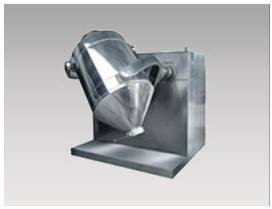
2. V-type mixer
The mixing principle of the V-type mixer is gravity convection diffusion mixing.
Advantages: ① There is no material dead corner during mixing.
② When the mixed powder has good flowability and similar physical properties, a good mixing effect can be obtained.
Disadvantages: ① Microscopically, the powder is not easily mixed evenly.
② Ultrafine powder and ultra-light powder are not easily mixed into the main powder.
③ There is gravity lifting motion, so the power consumption is high.
④ Throwing and smashing movements can damage the shape of the powder.
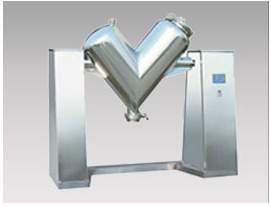
3. Double cone mixer
The mixing principle of a double cone mixer is gravity convection diffusion type mixing.
Advantages: ① The double conical cylinder is suitable for mixing without dead corners of the mixture.
② The gentle running speed will not cause damage to fragile materials.
③ It can meet the needs of large-scale batch mixing in production.
Disadvantages: ① Unable to achieve refined mixing.
② The mixing efficiency is low and the mixing time is long.
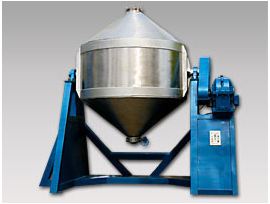
4. Horizontal ribbon blender
The mixing principle of the horizontal spiral belt mixer is: forced shear stirring type mixing.
Advantages: ① Large loading coefficient and small equipment footprint.
② The shear blades inside can achieve uniform mixing at the micro level.
③ According to the production demand, the equipment can be made into large-scale machines, which are relatively cheaper compared to other mixing machines.
Disadvantages: ① If the material bucket is fixed, there may be dead corners of the material.
② The startup load of the equipment is particularly large, making it difficult to start at full load and time-consuming and electricity consuming.
③ There is residue in the discharge.
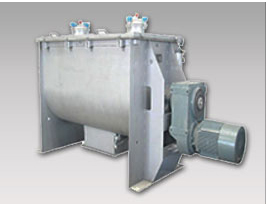
5. Single cone double helix mixer
The mixing principle of a single cone double helix mixer is: forced shear stirring type mixing.
Advantages: ① Simple structure, easy to make into a large machine.
② There will be no overheating of heat sensitive materials.
③ Can add spray device and heating.
Disadvantages: ① Long mixing time and low efficiency.
② The device height is too high. For the same mixed capacity, double helix equipment requires a height that is twice or even higher than other equipment.
③ There is a material dead corner at the bottom of the equipment, and it is necessary to repeatedly mix the bottom material with some discharge midway to avoid dead corners.
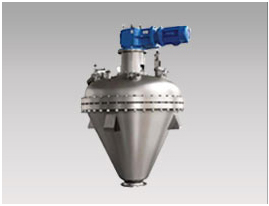
6. Horizontal weightless mixer
The mixing principle of a horizontal weightless mixer is: forced shear stirring type mixing.
Advantages: ① Fast speed, high mixing efficiency, sealable operation, economical and environmentally friendly.
② Throwing knives can be added to achieve mixing of materials with fibers.
③ The large door discharge method has a short discharge time, clean discharge, and compact structure.
Disadvantages: ① Unable to solve the mixing problem of significant differences in material proportions.
② During the mixing process, there may be blind spots in the mixing process.
③ During the mixing process, it is easy to damage the particle shape of the powder.
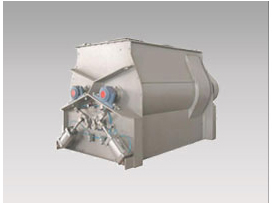
7. Double movement® Mixer
Dual motion ® The mixing principle of the mixer is: gravity diffusion type mixing superimposed with forced shear stirring type mixing.
Advantages: ① Ultra fine mixing achieves uniformity between particles.
② It can solve the problem of mixing light, heavy, and ultrafine powders.
③ The uniform speed operation saves time and electricity, and the use of a horizontal structure is much more convenient.
④ Uniform operation has little damage to the original appearance of the powder.
⑤ There are no dead corners of the material during mixing.
⑥ Dual motion ® The mixer can be made into a large mixer, such as a 7000 liter mixer.
Disadvantage: Currently, no obvious shortcomings of this device have been identified.
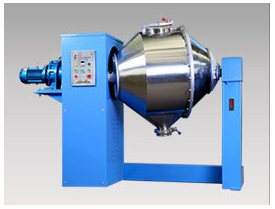
8. Square cone mixer
The mixing principle of the square cone mixer is gravity convection diffusion type mixing.
Advantages: ① Novel design, compact structure, beautiful appearance, and average mixing effect.
② No dead corners during fine polishing and mixing.
③ The lower end bucket of the square cone can be replaced as a storage bin for easy operation.
④ Convenient discharge and easy cleaning of the material barrel.
Disadvantages: ① Unable to achieve refined mixing.
② Due to equipment limitations, it is not easy to grow.
③ The equipment is complex and bulky, and the equipment cost is high.
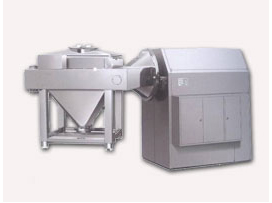
9. Planetary mixer
The mixing principle of planetary mixer is: centrifugal force drives convection diffusion type mixing.
Advantages: ① Not only does it rotate internally, but it also rotates itself, resulting in high precision and uniformity of mixing.
② No dead corners during fine polishing and mixing.
Disadvantages: ① High rotational speed has destructive power on powder particles.
② Due to equipment limitations, it is not easy to grow.
③ Due to its complex structure, the cost is relatively high.